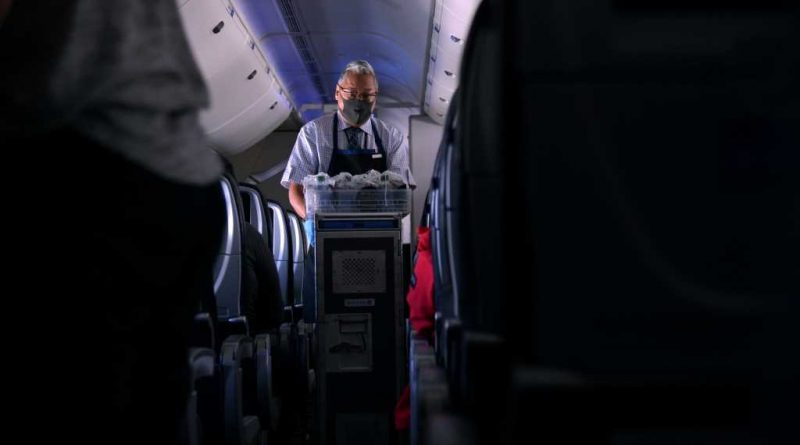‘It’s definitely not easy.’ How flight attendants are handling travel during COVID-19.
When Amber Gibson last flew from Chicago to Denver, she sat next to a passenger who was wearing a mask over his mouth but not his nose. Despite repeated requests from her and flight attendants, he refused to adjust his face covering. Since the flight was already delayed, Gibson agreed to move to a new seat after takeoff, only to be surrounded by more halfhearted maskers.
A masked flight attendant hands out refreshments on a flight from San Francisco, California, to Newark, New Jersey, on October 27, 2020. Flight attendants are more at risk for COVID than anyone else on a plane.
“Instead of forcing [my seatmate] off the plane, [the crew] made me feel like the bad guy because we had already pushed back from the gate,” says Gibson, a Chicago-based travel journalist. “Crew told me that if I insisted, we could go back, but it would further our delay, and did I want to waste everyone’s time?”
Gibson’s dilemma highlights one of many difficulties of traveling by air during a pandemic. Those who must fly have to untangle each airline’s safety protocols and worry about unpredictable fellow passengers, as well as the extent to which crew will deal with them. The issues are even more fraught for flight attendants, who must navigate a virus that still isn’t completely understood and non-compliant passengers who put crew members’ health—and jobs—at risk every day.
A World Economic Forum/Visual Capitalist report finds that transportation workers have the highest COVID-19 risk score—75.7 out of an average 30.2—of 966 non-health jobs assessed. Flight attendants are more at risk from COVID-19 than anyone else on a plane, just by the nature of their work. Close quarters mean they come within six feet of every passenger and each other multiple times during a flight. Flight attendants are vulnerable to contracting the virus when passengers remove their masks to eat or drink and when trying to convince an anti-masker to comply with rules.
San Francisco Bay, California
These unmanipulated images from Kost’s window seat help change perspectives and encourage travelers to leave the shades open. In this photo, microorganisms brighten up the San Francisco Bay salt ponds with vibrant colors.
Great Salt Lake, Utah
One of the largest saltwater lakes in the western hemisphere, the Great Salt Lake’s salinity levels—nearly four to 10 times the ocean’s—keep swimmers buoyant in its warm, shallow waters.
Las Vegas, Nevada
When taking a window-seat photograph, Kost suggests using the widest aperture setting on your camera to help minimize the appearance of dirt or scratches on the window. Here are more tips on how to take digital photos from a National Geographic photographer.
Southern Iceland
“I’ve always been drawn to photographs of ice,” says Kost. Here, Kost captures the frozen landscape of a country that is 11 percent ice.
Lake Mead National Recreation Area, Nevada
With three deserts and views of Hoover Dam, Lake Mead National Recreation Area became the country’s first congressionally designated National Recreation Area in 1964.
Mojave Desert, Nevada
When photographing through an airplane window, Kost says avoid using a polarizing filter. Most commercial airplane windows have a coating that reacts with polarizing filters, resulting in images with artificial-looking colors.
Great Salt Lake, Utah
Great Salt Lake’s shoreline is a hot spot for migratory birds, such as the tundra swan, American white pelican, white-faced ibis, California gull, eared grebe, peregrine falcon, and bald eagle. Explore more epic places to spot birds.
Landmannalaugar, Iceland
The colorful rhyolite mountains in Landmannalaugar, located inside Fjallabak Nature Reserve, hide pockets of geothermal hot springs that are open for a relaxing dip.
Valley of Fire State Park, Nevada
Named for its striking red Aztec sandstone formations, the Valley of Fire State Park, Nevada’s oldest and largest park, sits 50 miles northeast of Las Vegas and is a popular hiking and photography destination.
Southern Iceland
Kost considers a few factors before taking off. When possible, she recommends choosing seats that are in front of the engines to avoid distortions caused by the jet’s exhaust and wearing dark clothing to minimize window reflections.
Federal protections for crew members are limited, and each airline has its own set of policies. President Biden’s new federal mask mandate requiring face coverings in federal transportation areas, including in airports and on planes, may give more weight to the varied COVID-19 protection measures across the United States. But it’s not clear when the new mandate will go into effect or how it will be enforced.
In the meantime, cabin crew are still left with open-to-interpretation guidelines that vary from airline to airline—and few consequences for passengers who defy them. Besides that, other COVID-related workplace concerns remain, such as inconsistent policies on contact tracing, testing, and quarantine, plus potentially punitive consequences for crew members who miss shifts to isolate after exposure to the virus.
Planes are relatively safe, but not risk free
Research has established that the air on planes is cleaner than that of almost all other indoor spaces, thanks to sophisticated air circulation systems and HEPA filters. In addition, electrostatic fog sanitizing, airline mask rules, and procedural changes to reduce touchpoints have all helped crew members, such as Roshonda Payne, feel safer. “I think just learning more about all the products, processes, and systems has helped me build confidence and that of my customers,” says the Los Angeles-based flight attendant for the hop-on jet service JSX.
(Planes and airports are going high-tech to make travel safer during the pandemic.)
Still, planes aren’t completely safe. Late last year, researchers determined that four people likely caught COVID-19 on an 18-hour flight from Dubai to Auckland in September. Two of the four did not wear masks during the flight, which was only a quarter filled.
Requirements to provide a negative COVID-19 test before boarding, such as the new rule for flying into the U.S., don’t eliminate the risk. In January, people flying to the February 2021 Australian Open tennis tournament on chartered flights had to provide a negative test. Yet upon arrival, at least five people from three different flights tested positive.
Compounding the uncertainty are several new, more contagious strains of the virus and news from Europe that cloth masks aren’t adequate protection. Austria, France, and Germany now require medical-grade masks on public transportation. While vaccines rolling out are a cause for hope, we don’t yet know if they prevent disease transmission and, so far, only a small percentage of the global population has been vaccinated.
Policing masks—the toughest part of the job
Despite the uncertainties, scientists say that masks are still the best protection against the virus. Yet, in the air, flight attendants have a tough time dealing with passengers who refuse to comply with mask rules. One flight attendant, who wasn’t authorized to speak on the record, says some rule-breakers claim discrimination or mock and dispute crew’s authority.
Other flight attendants relay stories of passengers taking advantage of the mask exception for eating and drinking. These passengers, one source says, spent the entire flight sipping from almost-empty glasses or slowly nibbling snacks when cabin crew were near.
“It’s definitely not easy to be repeatedly challenged” about mask wearing, says Payne. She encounters reluctant maskers several times per week on JSX’s 30-seat planes, which fly between private terminals. “I get that some [people] don’t like wearing them. I don’t like it either,” she notes, “but it’s vitally important to keeping everyone safe and protected.”
“Ideally, everyone should want to wear a mask for the sake of others, if not for their own well-being,” says Sharona Hoffman, a professor and co-director of Case Western Reserve University’s Law-Medicine Center. She explains that airlines have ways to compel people to comply, including removing passengers who refuse to mask up while the plane is still at the gate and placing rule flaunters on a no-fly list. In 2020, U.S. airlines banned more than 1,400 travelers for mask infractions.
(Here’s how to limit your COVID-19 risk while traveling.)
Still, flight attendants have limited authority to enforce the rules and struggle with inconsistent direction from higher-ups. Some are instructed to do no more than provide reminders to passengers about masking up. Yet they say management is quick to pass on complaints from passengers who accuse crew of not doing enough.
The airline industry is hopeful that President Biden’s mask executive order will help minimize onboard tussles. “Now that the executive action mask mandate goes beyond the airline policy, we know this will provide the backup flight attendants and aviation workers on the front lines have needed since the beginning of this pandemic,” says Taylor Garland, spokesperson for the Association of Flight Attendants-CWA union, which represents crew at 17 airlines.
Biden’s mandate may boost the Federal Aviation Administration’s January 13, 2021 order. That order stepped up enforcement against bad passenger behavior, including disruptive anti-maskers, in the wake of incidents on flights surrounding the January 6, 2021 siege of the U.S. Capitol. Now passengers who “assault, threaten, intimidate, or interfere” with airline crew members are much more likely to face fines up to $35,000 or imprisonment.
But the mandate’s lack of enforcement leaves things a little up in the air. “Local and state mandates have certainly helped us enforce the mask rule,” says Payne, “but it remains to be seen what impact the national mandate will have on our flights.”
Lingering concerns
Even if it were enforceable, the mask mandate doesn’t address the other key concern for flight attendants: the lack of national crew contact tracing, testing, and quarantine standards that airlines must follow. This applies to crew members who are worried they’ve been exposed to COVID-19 and want to be tested, those waiting for test results, and those who test positive. It should be a concern for passengers, too.
One flight attendant, who asked to remain anonymous to protect their job, says that federal guidelines leave too much to airline discretion. They said that current guidelines allow airlines to create policies—such as COVID-19 exposure notifications—that favor keeping flight attendants on the job over keeping employees and passengers safe.
Another flight attendant pointed to their airline’s policy to send email notifications about positive tests as an example. This policy doesn’t ensure that all staff receive it before their shifts. As a result, a flight attendant learned from fellow workers—not from management—that two colleagues they recently flew with tested positive.
American Airlines’ policy is to remove from service all crew who worked with an infected person. But several airlines broadly interpret FAA and CDC guidelines, which unrealistically define “close contact,” given how flight attendants work in tight spaces. Testing is mandatory only under specific circumstances; otherwise crew are instructed to continue working and monitor for symptoms. That’s risky when studies show that 59 percent of COVID-19 cases are transmitted by asymptomatic or presymptomatic people.
Testing overall is problematic due to each airlines’ differing policies. Some airlines provide at-home tests if employees have been exposed, but only if they have symptoms. At some airlines, those who want more conclusive PCR tests must pay for it themselves and take it on their own time, even if they’ve received an at-work exposure notification. Regardless, one test does not mean a person is COVID-free, especially shortly after exposure.
(How good is COVID-19 testing in the U.S. right now?)
Missing work due to exposure to coronavirus can be stressful, too. One person, who also didn’t want to be identified, says that some crew members are afraid to miss work if they’re sick or believe they’ve contracted the virus, even when that exposure was on the job. They say that pay protection applies only if their test is positive.
Aircrew unions continue their calls for greater consistency in safety protocols and a “proactive and fulsome federal response to COVID in aviation and beyond,” says the AFA. Making guidelines, such as the FAA’s December 2020 Safety Alert, mandatory would help. Currently, that alert states only that the “CDC does not recommend allowing crew members with known exposures to continue to work, even if asymptomatic.”
Industry-wide standards would help ensure the most effective policies are practiced to protect all crew and passengers, whether it’s with contact tracing, symptom screening like temperature checks, boarding and deplaning methods, blocking middle seats, food and drink service (especially selling snacks on short-haul flights), or determining exceptions for wearing masks. It would also eliminate the onus on travelers to research each airline’s safety measures and for flight crew to explain each airline’s policies.
To date, 25 percent of the world’s nearly 100 million COVID-19 cases are active. More than two million people have died from the disease. Despite the ongoing risks and warnings against traveling, millions of people take to the skies every day.
Until a majority of the world is vaccinated and infection numbers significantly come down, following the rules may be the best way to get back to normal for everyone. Whether they come from the airlines or the federal government, one simple rule to wear a mask can save millions of lives.
Johanna Read is a Canadian writer and photographer specializing in responsible tourism. A former government policy executive, she’s worked on issues including workplace health and pandemic influenza. Follow her on Twitter and Instagram.
Source: Read Full Article














